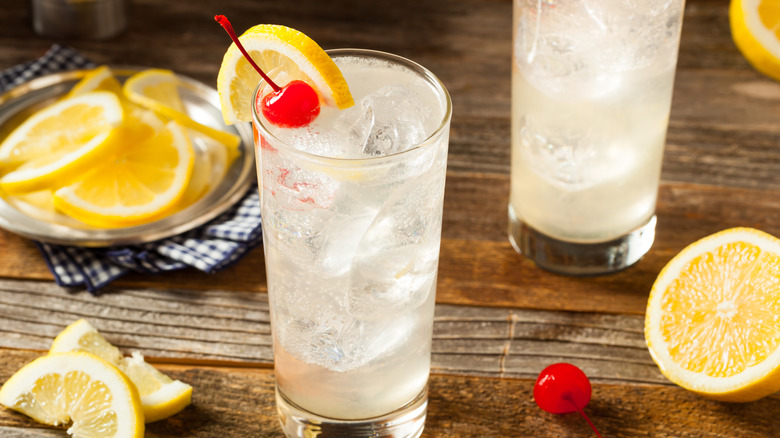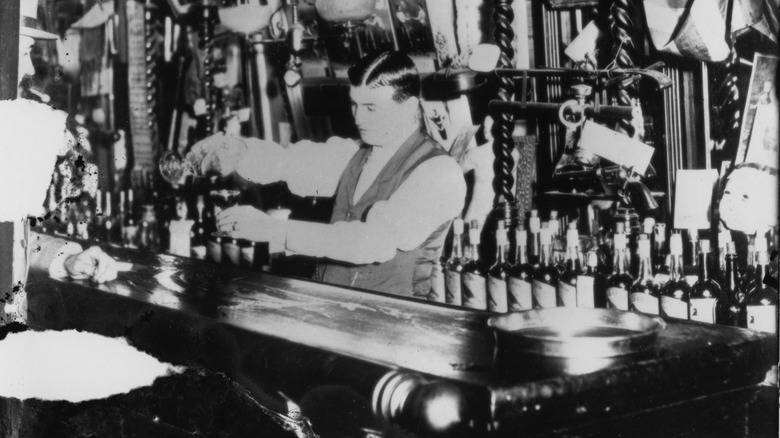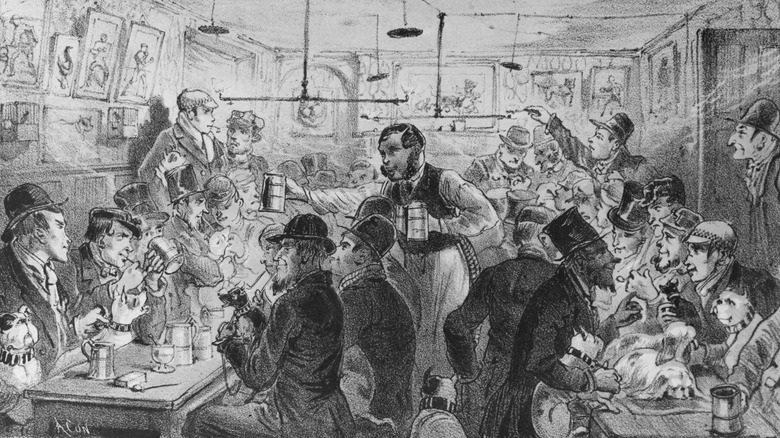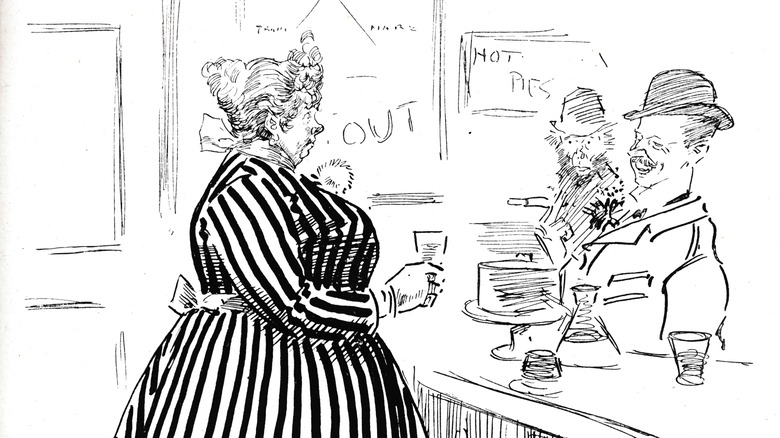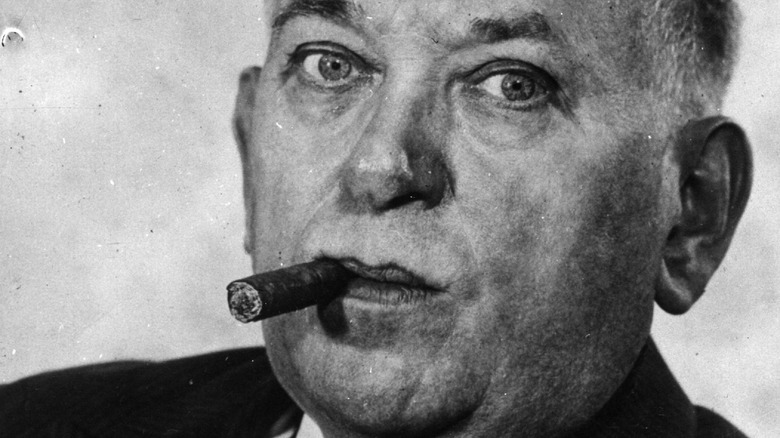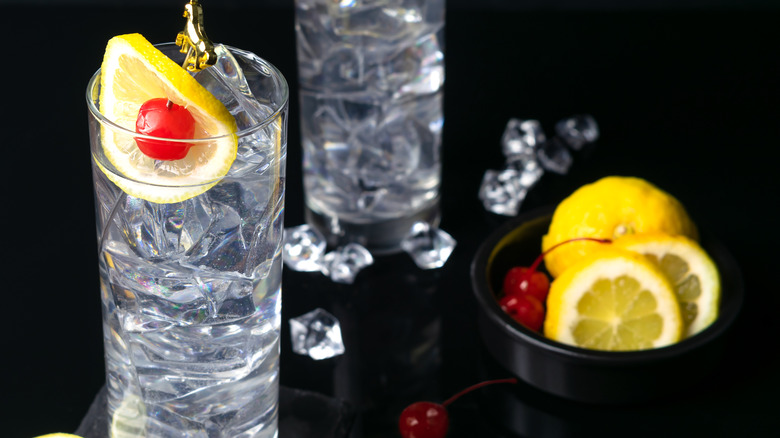The Biggest Theories On How The Classic Tom Collins Cocktail Got Its Name
The Tom Collins is a simple, refreshing, well-known cocktail made with gin, lemon juice, sugar, and soda water, and served in a tall Collins glass with ice garnished with lemon slices and a maraschino cherry. Like many cocktails, the origin of the name "Tom Collins" and how it came to be uses for this particular drink is hazy, with several theories that may or may not accurately tell the tale.
Per the website for the Mr. Boston drinks guide, Collins drinks came to be in the 1870s and inspired the Collins glasses, which are described as "tall, narrow and straight-sided," essentially a larger version of a Fizz or Highball glass and capable of holding 14 to 16 ounces. According to the Online Wine Course, the Tom Collins was preceded by the John Collins, a similar drink that called for genever, a "malty, sweet spirit from Holland made with juniper that most consider the predecessor of gin."
From John Collins to Tom Collins
The Online Wine Course goes on to note that the John Collins name came from the headwaiter at Limmer's Old House, a hotel and coffee house in London, England in the late 18th century to early 19th century. Eventually, the brands London Gin and Old Tom Gin came into fashion, and "The Steward and Barkeeper's Manual of 1869" referenced the recipe for John Collins, replacing genever with, specifically, Old Tom Gin. It's possible that patrons asking for an "Old Tom Collins" led to the gin, lemon, sugar, and soda drink becoming known as the Tom Collins.
In 2008, mixologist Gaz Regan wrote about Tom Collins history for the San Francisco Chronicle and shared a song that had existed about the original John Collins: "My name is John Collins, headwaiter at Limmer's / Corner of Conduit Street, Hanover Square / My chief occupation is filling brimmers / For all the young gentlemen frequenters there." Regan also discussed another possible origin for the Tom Collins moniker, which came from the 1870s equivalent of a meme.
The naming controversy began early on
Controversy over the origin of the Collins family of drinks is a time-honored tradition. In 1891, a short paragraph in British humor periodical Punch took issue with a recent article by Sir Morell Mackenzie, M.D., that had run in The Fortnightly mentioning the aforementioned "John Collins" song and claiming it was the inspiration behind the Collins drinks. Punch claimed the song that celebrated "more of the early mornings and late nights, more of the rough-and-ready," was actually called "Jim Collins" whereas Mackenzie's "John Collins" song was "the veneered version for the drawing room."
This gives credence to another theory regarding the Tom Collins origin story. Per Gaz Regan in the San Francisco Chronicle, in 2006, "bartender, drink historian, blogger and all-around mischief-maker" George Sinclair wrote for the British magazine Class about the "Great Tom Collins Hoax of 1874." In 1874 London, it became a trendy game or joke for a man to tell a friend with whom he was drinking in a tavern that he'd met someone named Tom Collins who'd been disparaging the friend.
The Tom Collins Hoax was an early meme
As reported in the San Francisco Chronicle, this "Tom Collins Hoax" led to an onslaught of offended men stalking around London pubs looking for this mysterious "Tom Collins" who'd been slandering their good names. The outcome was a drink named Tom Collins, named for the joke, and yet another possible reason for the cocktail's appellation.
Another ongoing discussion regarding the Tom Collins is whether it's actually American or British in origin. It's generally agreed that the first written recipe for the drink appeared in the 1876 edition of pioneering New York bartender Jerry Thomas' "Bar-Tender's Guide." Per The New York Times, Thomas published the very first edition in 1862, making it the first drink book published in the United States. In 1899, American writer Charles Montgomery Skinner wrote in his book "Myths and Legends Beyond Our Borders" that American-style bartending was "studied by French, German, and English without avail," seen as an "American art." Skinner wrote that cocktails were particularly "stimulating of curiosity" and specifically mentioned the Tom Collins.
Is the Tom Collins from England or the United States?
In his 1921 book "The American Language: An Inquiry into the Development of English in the United States," writer and satirist H.L. Mencken wrote about "curious American drinks," including both the Tom Collins and the John Collins, and opined that while the origin of most cocktails "remains to be established," Americans were more likely than the British to be creative when it came to drink names. Mencken pointed out that the British showed "a far more limited imagination" when naming cocktails, comparing the plain, self-evident "whiskey-and-soda" which in the United States goes by "the far more original name of high-ball."
Yet another possible and distinctly American origin story regarding the Tom Collins was reported by the website Early St. Louis Hotels. Per writer David A. Lossos, the Planter's Hotel of St. Louis, Missouri, which is also credited with inventing the Planter's Punch cocktail, had a popular main bar that served as a gathering spot for the community. Bartender Charles Dietrich is said to have invented the "cool and refreshing" Tom Collins and named it after a regular patron. As the iteration of the Planter's Hotel with the main bar was completed in 1891, and the Tom Collins appeared in a 1876 bartending guide, this seems like a less likely origin story.
Shaken or stirred? It depends!
Regardless of the origin of the name and contents of the Tom Collins cocktail, there's general agreement about the drink's status as a classic in its field. The New York Times called it "the ultimate highball" as well as an "enduring classic," noting that the traditional Old Tom gin is particularly good because it's a sweet gin, as opposed to a dry gin. Richmond Magazine instructed at-home mixologists that the most important ingredient in a Tom Collins is fresh-squeezed citrus and, unlike the Times, observes that modern versions of the drink often include a more dry gin as opposed to the classic sweet, barrel-aged version.
The article goes on to lay out the mild controversy regarding whether a Tom Collins is better stirred, which is called for in Jerry Thomas' 1876 recipe, or shaken, which is the modern norm when it comes to drinks containing citrus as "unaerated lemon juice can taste oily and flat." Bar Manager Shannon Hood offers the opinion that shaking dilutes the drink too much; one possible compromise is shaking the contents alone and pouring it over ice in a Collins glass.
